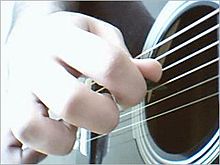The banjo is a stringed instrument with a thin membrane stretched over a frame or cavity to form a resonator. The membrane is typically circular, in modern forms usually made of plastic, originally of animal skin. Early forms of the instrument were fashioned by African Americans and had African antecedents. In the 19th century, interest in the instrument was spread across the United States and United Kingdom by traveling shows of the 19th century minstrel show fad, followed by mass-production and mail-order sales, including instruction method books. The inexpensive or home-made banjo remained part of rural folk culture, but 5-string and 4-string banjos also became popular for home parlour music entertainment, college music clubs, and early 20th century jazz bands. By the early 21st century, the banjo was most frequently associated with folk, bluegrass and country music, but was also used in some rock, pop and even hip-hop music. Among rock bands, the Eagles, Led Zeppelin, and the Grateful Dead have used the five-string banjo in some of their songs.

The classical guitar, also called Spanish guitar, is a member of the guitar family used in classical music and other styles. An acoustic wooden string instrument with strings made of gut or nylon, it is a precursor of the modern steel-string acoustic and electric guitars, both of which use metal strings. Classical guitars derive from the Spanish vihuela and gittern of the 15th and 16th century. Those instruments evolved into the 17th and 18th-century baroque guitar—and by the mid-19th century, early forms of the modern classical guitar. Today's modern classical guitar was established by the late designs of the 19th-century Spanish luthier, Antonio Torres Jurado.

The guitar is a fretted musical instrument that typically has six strings. It is usually held flat against the player's body and played by strumming or plucking the strings with the dominant hand, while simultaneously pressing selected strings against frets with the fingers of the opposite hand. A plectrum or individual finger picks may also be used to strike the strings. The sound of the guitar is projected either acoustically, by means of a resonant chamber on the instrument, or amplified by an electronic pickup and an amplifier.
In music, tremolo, or tremolando, is a trembling effect. There are two types of tremolo: either a rapid repetition of a note, or a variation in volume.

A plectrum is a small flat tool used for plucking or strumming of a stringed instrument. For hand-held instruments such as guitars and mandolins, the plectrum is often called a pick and is held as a separate tool in the player's hand. In harpsichords, the plectra are attached to the jack mechanism.

Clawhammer, sometimes called down-picking, overhand, or frailing, is a distinctive banjo playing style and a common component of American old-time music.

A guitar pick is a plectrum used for guitars. Picks are generally made of one uniform material—such as some kind of plastic, rubber, felt, tortoiseshell, wood, metal, glass, tagua, or stone. They are often shaped in an acute isosceles triangle with the two equal corners rounded and the third corner less rounded. They are used to strum chords or to sound individual notes on a guitar.
Lead guitar is a musical part for a guitar in which the guitarist plays melody lines, instrumental fill passages, guitar solos, and occasionally, some riffs and chords within a song structure. The lead is the featured guitar, which usually plays single-note-based lines or double-stops. In rock, heavy metal, blues, jazz, punk, fusion, some pop, and other music styles, lead guitar lines are usually supported by a second guitarist who plays rhythm guitar, which consists of accompaniment chords and riffs.

A fingerpick is a type of plectrum used most commonly for playing bluegrass style banjo music. Most fingerpicks are composed of metal or plastic. Unlike flat guitar picks, which are held between the thumb and finger and used one at a time, fingerpicks clip onto or wrap around the end of the fingers and thumb; thus one hand can pick several strings at once. Generally four are used: one for the thumb, and one each for the ring, middle and index fingers. Fingerpicks worn on the thumb are generally called "thumbpicks". Some players use a plastic thumbpick while using metal fingerpicks. Fingerpicks come in a variety of thicknesses to accommodate different musicians' styles of playing. Thin picks produce a quieter, more delicate sound, while thick picks produce a heavier sound. But as with standard plectrums, thumbpicks come in different styles and employ different materials.
Rasgueado is a guitar finger strumming technique commonly associated with flamenco guitar music. It is also used in classical and other fingerstyle guitar picking techniques. The rasgueado is executed using the fingers of the strumming hand in rhythmically precise, and often rapid, strumming patterns. The important characteristic of this strumming style is the fingernail (outer) side of the finger tips is also used, and in such case, in reverse of the way it is done when the fleshy side of the finger tips is used, namely downward and upward (thumb).

Fingerstyle guitar is the technique of playing the guitar or bass guitar by plucking the strings directly with the fingertips, fingernails, or picks attached to fingers, as opposed to flatpicking. The term "fingerstyle" is something of a misnomer, since it is present in several different genres and styles of music—but mostly, because it involves a completely different technique, not just a "style" of playing, especially for the guitarist's picking/plucking hand. The term is often used synonymously with fingerpicking except in classical guitar circles, although fingerpicking can also refer to a specific tradition of folk, blues and country guitar playing in the US. The terms "fingerstyle" and "fingerpicking" are also applied to similar string instruments such as the banjo.
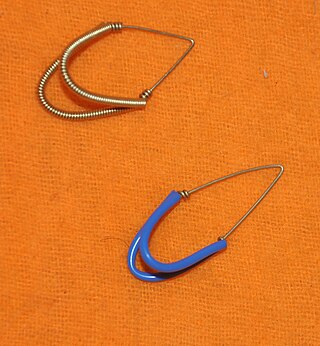
A mezrāb or mizrab, also known as a zakhmeh or is a plectrum which is used for several Iranian and Indian string instruments.

In music, strumming is a way of playing a stringed instrument such as a guitar, ukulele, or mandolin. A strum or stroke is a sweeping action where a finger or plectrum brushes over several strings to generate sound. On most stringed instruments, strums are typically executed by a musician's designated strum hand, while the remaining hand often supports the strum hand by altering the tones and pitches of any given strum.
Downpicking, sometimes referred to as down-stroke picking, is a technique used by musicians on plucked string instruments in which the player moves the plectrum, or pick in a downward motion, relative to the position of the instrument, against one or more of the strings to make them vibrate. If down-strokes are played without the addition of upstrokes, the tip of the pick never comes in contact with the strings as the hand moves back up to repeat the down-stroke.
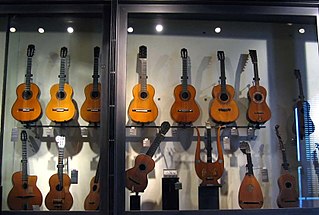
The following outline is provided as an overview of and topical guide to guitars:
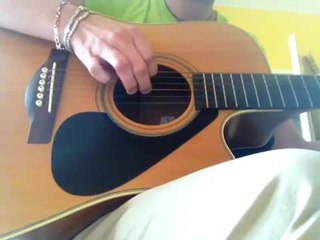
Hybrid picking is a guitar-playing technique that involves picking with a pick (plectrum) and one or more fingers alternately or simultaneously. Hybrid picking allows guitar players who use a pick to perform music which would normally require fingerstyle playing. It also facilitates wide string leaps which might otherwise be quite difficult. The technique is not widespread in most genres of guitar playing, but is most often employed in "chicken pickin'"; rockabilly, country, honky-tonk, and bluegrass flatpicking styles who play music which occasionally demands fingerstyle passages.
Hybrid picking involves playing with the pick and the right hand m and/or a fingers...at the same time. The pick is held in the usual way...and the fingers execute free strokes in the typical fingerstyle manner...Hybrid picking allows fingerstyle-like passages to be freely interspersed with flatpicked passages...without any delay.
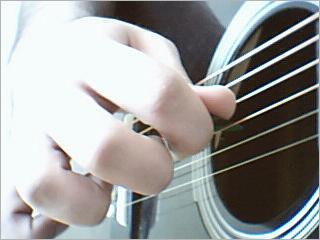
Flatpicking is the technique of striking the strings of a guitar with a pick held between the thumb and one or two fingers. It can be contrasted to fingerstyle guitar, which is playing with individual fingers, with or without wearing fingerpicks. While the use of a plectrum is common in many musical traditions, the exact term "flatpicking" is most commonly associated with Appalachian music of the American southeastern highlands, especially bluegrass music, where string bands often feature musicians playing a variety of styles, both fingerpicking and flatpicking. Musicians who use a flat pick in other genres such as rock and jazz are not commonly described as flatpickers or even plectrum guitarists. As the use of a pick in those traditions is commonplace, generally only guitarists who play without a pick are noted by the term "fingerpicking" or "fingerstyle".
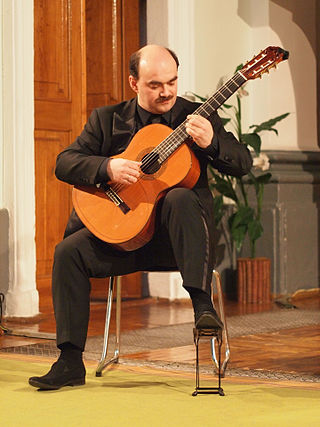
In classical guitar, the right hand is developed in such a way that it can sustain two, three, and four voice harmonies while also paying special attention to tone production. The index (i), middle (m), and ring (a) fingers are generally used to play the melody, while the thumb (p) accompanies in the bass register adding harmony and produces a comparable texture and effect to that of the piano. The classical guitar is a solo polyphonic instrument, and it is difficult to master.

A flamenco guitar is a guitar similar to a classical guitar but with thinner tops and less internal bracing. It usually has nylon strings, like the classical guitar, but it generally possesses a livelier, more gritty sound compared to the classical guitar. It is used in toque, the guitar-playing part of the art of flamenco.

An acoustic guitar is a musical instrument in the string family. When a string is plucked, its vibration is transmitted from the bridge, resonating throughout the top of the guitar. It is also transmitted to the side and back of the instrument, resonating through the air in the body, and producing sound from the sound hole. The original, general term for this stringed instrument is guitar, and the retronym 'acoustic guitar' distinguishes it from an electric guitar, which relies on electronic amplification. Typically, a guitar's body is a sound box, of which the top side serves as a sound board that enhances the vibration sounds of the strings. In standard tuning the guitar's six strings are tuned (low to high) E2 A2 D3 G3 B3 E4.


